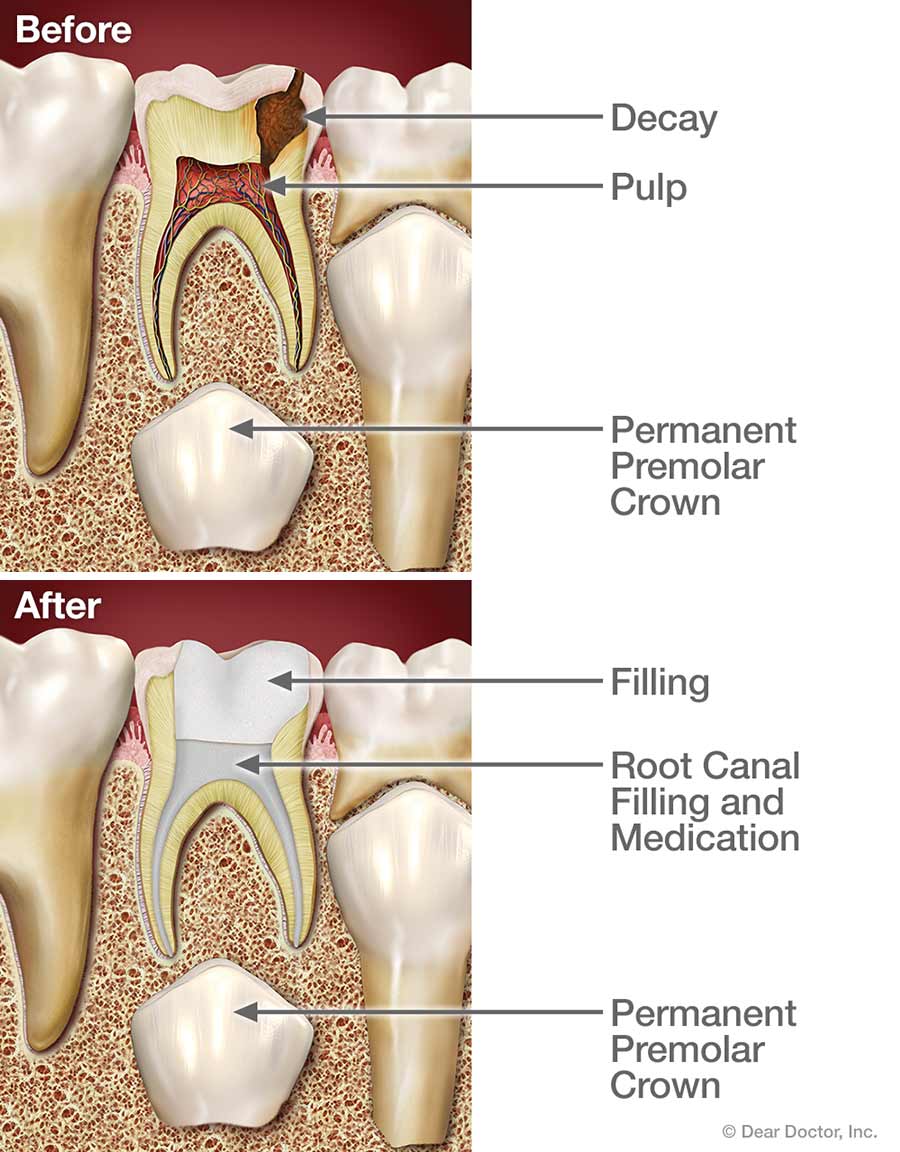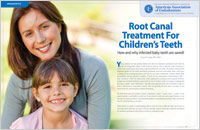 Root canal treatment is a safe and effective way to stop many kinds of tooth pain, and to keep a tooth from being lost due to decay or injury. But if a root canal is recommended for your young child, you may wonder why: Isn't that baby tooth going to fall out in a few years anyway?
Root canal treatment is a safe and effective way to stop many kinds of tooth pain, and to keep a tooth from being lost due to decay or injury. But if a root canal is recommended for your young child, you may wonder why: Isn't that baby tooth going to fall out in a few years anyway?
That's true — the primary (baby) teeth typically are shed between the ages of 6 and 12 years. Yet there are some good reasons for trying to save baby teeth for as long as possible with root canal treatment, rather than simply extracting any that are damaged by trauma or infection.
For one, primary teeth have the same functions as adult teeth — and a missing tooth at any age can cause problems with speech and eating. Baby teeth also have another important role: They serve as guides for the proper placement of the permanent teeth. Without primary teeth to guide them in, permanent teeth tend to emerge in a crooked fashion, often becoming tilted or crowded because of inadequate space. This can result in bite problems that may require extensive orthodontic treatment later.
Saving The Tooth Is Always Best

Unlike its hard outer surface, the soft pulp inside the tooth is rich in blood vessels and nerves. Problems in this area are often signaled by tooth sensitivity and pain. When we find these symptoms during an examination, we generally use radiographs (x-rays) to confirm that the pulp is diseased, or dying. That's when we need to take action, before an abscess or further infection can develop.
In severe cases, the tooth may need to be removed, and a space maintainer installed to fill the gap. But many times, space maintainers don't fully restore the tooth's functionality. Plus, they are susceptible to coming loose and must be monitored constantly. If possible, we prefer to use treatment methods such as:
- Indirect pulp treatment. If pulp damage is minimal, it's possible to remove most of the decay (but not the pulp), apply an antibiotic, and then seal the tooth up again; that's referred to as an "indirect" treatment.
- Pulpotomy. Alternatively, if decay is limited to the upper portion of the pulp, we may recommend a "pulpotomy." This involves removing the damaged part of the pulp, stabilizing the remaining healthy portion, and then disinfecting and sealing the tooth. This "partial" root canal is a time-tested technique that's successful in many cases.
- Pulpectomy. If pulp tissue is infected through the entire tooth structure, a pulpectomy may be needed. Here, we remove all pulp tissue, disinfect and shape the canals, then fill and seal them with inert material. Afterwards, the crown (visible part) of the tooth will be restored. This resembles traditional root canal therapy, with a crucial difference: The sealant we use in children is capable of being dissolved by the body. That way, when it's time for a permanent tooth to erupt, the baby tooth's roots can be naturally absorbed and tooth development can proceed normally.
Preparing for Your Child's Root Canal Treatment
As you probably already know, most of the legends you may have heard about root canal therapy simply aren't true. In fact, the procedure generally causes little discomfort, but is quite successful in relieving tooth pain! We are adept at using anesthesia to block the sensation of pain, and experienced in calming the fears of young ones. While it's understandable that you may be nervous, it will help if you don't let your child pick up on your own anxiety. A calming voice and a gentle touch can do much to relieve stress.
After a thorough examination, we will recommend the best options for your child's treatment. The procedures are routinely done right here in our office. Afterwards, we will give you complete follow-up instructions, and schedule a return visit. A root canal is nothing to fear: Think of it as a treatment that may save your child from some tooth pain now, and potentially a lot of corrective dental work later on.
Related Articles

Root Canal Treatment for Children's Teeth You may think that if a baby tooth comes out prematurely, it's no great loss; after all, it was going to fall out anyway, right? Wrong! Primary (baby) teeth serve as important guides for the permanent teeth that will replace them. Losing baby teeth prematurely can allow bite problems to develop. Root canal treatment for children can prevent this. Learn what to look for in your child and what can be done to save baby teeth until they are ready to be lost naturally... Read Article

Tooth Pain? Don't Wait! Pain is a protective response that informs the body that something is wrong. Tooth pain, specifically, is caused by a reaction of the nerves inside a tooth's pulp chamber, with the severity dependent upon the type and degree of the stimulus. This article gives some examples of pain symptoms and their possible causes... Read Article

